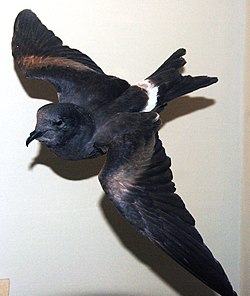Guadalupe storm petrel
| Guadalupe storm petrel | |
|---|---|
 |
|
| Mounted specimen, Field Museum | |
| Scientific classification | |
| Kingdom: | Animalia |
| Phylum: | Chordata |
| Class: | Aves |
| Order: | Procellariiformes |
| Family: | Hydrobatidae |
| Subfamily: | Hydrobatinae |
| Genus: | Oceanodroma |
| Species: | O. macrodactyla |
| Binomial name | |
|
Oceanodroma macrodactyla W.E. Bryant, 1887 |
|
| Synonyms | |
|
Oceanodroma leucorhoa macrodactyla W.E. Bryant, 1887 |
|
Oceanodroma leucorhoa macrodactyla W.E. Bryant, 1887
The Guadalupe storm petrel (Oceanodroma macrodactyla) is a small seabird of the storm petrel family Hydrobatidae. It is apparently extinct.
This species was almost indistinguishable from its relative, Leach's storm petrel. In the field, they could not be told apart except by their annual rhythm. In the hand, the Guadalupe storm petrel could be distinguished by slightly larger size and the paler underwing coverts.
It bred only on Guadalupe Island off Baja California, Mexico, and presumably ranged throughout the region. The breeding season was set between that of the local subspecies of Leach's storm petrel, the winter-breeding Oceanodroma leucorhoa cheimomnestes and the summer-breeding O. l. socorroensis, in accordance with Gause's Law.
The single egg, white with a faint ring of reddish-brown and lavender speckles around the blunt end, was laid in burrows maybe 15 inches (35–40 cm) long, below the Guadalupe pine (Pinus radiata var. binata)-island oak (Quercus tomentella)cloud forest on top of Mount Augusta. By mid-June, almost all young had already left the burrows. Though there is little data on Oceanodroma breeding, incubation was presumably 42 days or so in this species, just as in similar-sized relatives. Time to fledging must have taken between 60 and 75(−85?) days, most likely around 65 days. This would mean that egg-laying took place from early February to March, and that in April–May, unfledged young were present in most active burrows. just as in their relatives, the egg was incubated a few days by either parent, after which the other took over, the relieved bird taking to the sea to satiate themselves for the next incubation stint. The young were fed only at night, also like in other storm petrels.
...
Wikipedia

